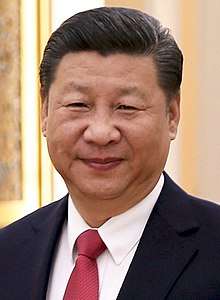Government of China
.svg.png) Emblem of the People's Republic of China | |
| Formation | 1 October 1949 |
|---|---|
| Legislature | National People's Congress |
| Website | English.gov.cn |
| Communist Party | |
| Party | Communist Party of China |
| General Secretary | Xi Jinping[1] |
| Government | |
| Executive |
State Council (Li Keqiang Government) |
| President | Xi Jinping |
| Premier | Li Keqiang |
| Congress Chairman | Li Zhanshu |
| Armed Forces | |
| Military |
People's Liberation Army People's Armed Police |
| Military Chairman | Xi Jinping |
| Government of the People's Republic of China | |||||||
| Traditional Chinese | 中華人民共和國政府 | ||||||
|---|---|---|---|---|---|---|---|
| Simplified Chinese | 中华人民共和国政府 | ||||||
| |||||||
The central government of the People's Republic of China is divided among several state organs:
- the legislative branch, the National People's Congress and its Standing Committee
- the presidency, including the President and the Vice-President
- the executive branch, the State Council (constitutionally synonymous with the "Central People's Government"), whose Premier is the head of government
- the military branch, the People's Liberation Army (PLA) and the People's Armed Police (PAP), via the Central Military Commission, whose Chairman is the Commander-in-chief
- the supervisory branch, the National Supervisory Commission
- the judicial branch, the Supreme People's Court and the Supreme People's Procuratorate
The legal power of the Communist Party is guaranteed by the PRC Constitution and its position as the supreme political authority in the PRC is realised through its comprehensive control of the state, military, and media.[2] According to a prominent government spokesman:
We will never simply copy the system of Western countries or introduce a system of multiple parties holding office in rotation; although China’s state organs have different responsibilities, they all adhere to the line, principles and policies of the party.[3]
The primary organs of state power are the National People's Congress (NPC), the President, and the State Council. Members of the State Council include the Premier, a variable number of Vice Premiers (now four), five State Councilors (protocol equal of vice premiers but with narrower portfolios), and 29 ministers and heads of State Council commissions. During the 1980s there was an attempt made to separate party and state functions, with the party deciding general policy and the state carrying it out. The attempt was abandoned in the 1990s with the result that the political leadership within the state are also the leaders of the party. This dual structure thereby creates a single centralized focus of power.
At the same time there has been a move to separate party and state offices at levels other than the central government. It is not unheard of for a sub-national executive to also be party secretary. This frequently causes conflict between the chief executive and the party secretary, and this conflict is widely seen as intentional to prevent either from becoming too powerful. Some special cases are the Special Administrative Regions of Hong Kong and Macau where the Mainland Chinese national laws do not apply at all and the autonomous regions where, following Soviet practice, the chief executive is typically a member of the local ethnic group while the party general secretary is non-local and usually Han Chinese.
Under the Constitution of China, the NPC is the highest organ of state power in China. It meets annually for about two weeks to review and approve major new policy directions, laws, the budget, and major personnel changes. Most national legislation in the PRC is adopted by the Standing Committee of the National People's Congress. Most initiatives are presented to the NPCSC for consideration by the State Council after previous endorsement by the Communist Party's Politburo Standing Committee. Although the NPC generally approves State Council policy and personnel recommendations, the NPC and its standing committee has increasingly asserted its role as the national legislature and has been able to force revisions in some laws. For example, the State Council and the Party have been unable to secure passage of a fuel tax to finance the construction of expressways.[4][5]
Decision-making Body
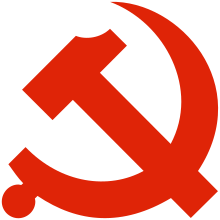
The Politburo Standing Committee (PSC), is a committee consisting of the top leadership of the Communist Party of China. Historically it has been composed of five to nine members, and currently has seven members. Its officially mandated purpose is to conduct policy discussions and make decisions on major issues when the Politburo, a larger decision-making body, is not in session. According to the party's Constitution, the General Secretary of the Central Committee must also be a member of the Politburo Standing Committee.[6]
The membership of the PSC is strictly ranked in protocol sequence. Historically, the general secretary (or party chairman) has been ranked first; the rankings of other leaders have varied over time. Since the 1990s, the general secretary, premier, chairman of the National People's Congress, the chairman of the Chinese People's Political Consultative Conference, the secretary of the Central Commission for Discipline Inspection, the party's top anti-graft body, and the first-ranked secretary of the secretariat have consistently also been members of the Politburo Standing Committee.[7]
Paramount leader
Power is concentrated in the Paramount leader, currently Xi Jinping, who heads the four most important political and state offices: He is General Secretary of the Communist Party, general secretary of the Central Committee, Chairman of the Central Military Commission, and President of the PRC.[8] Recently, experts have observed growing limitations to the Paramount leader's de facto control over the government.[9]
Constitution
The Constitution was first created on September 20, 1954. Before that an interim constitution-like document created by the Chinese People's Political Consultative Conference was in force. The second promulgation in 1975 shortened the Constitution to just about 30 articles, and contained Communist slogans and revolutionary language throughout. The role of courts was slashed, and the Presidency was gone. The 3rd promulgation in 1978 expanded the number of articles, but was still under the influence of the just-gone-by Cultural Revolution.
The current constitution is the PRC's fourth promulgation. On December 4, 1982, it was promulgated and has served as a stable constitution for 30 years. The roles of the presidency and the courts were normalized, and under the constitution, all citizens were equal. Amendments in 1988, 1993, 1999, 2004, and 2018 recognized private property, safeguarded human rights, and further promoted the non-public sector of the economy.
National People's Congress
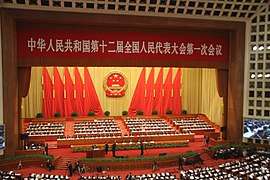
The National People's Congress (usually abbreviated NPC) is the national legislature of the People's Republic of China. With 2,924 members in 2017, it is the largest parliamentary body in the world.[10] Under China's current Constitution, the NPC is structured as a unicameral legislature, with the power to legislate, the power to oversee the operations of the government, and the power to elect the major officials of state. The NPC and the National Committee of the People's Political Consultative Conference (CPPCC), a consultative body whose members represent various social groups, are the main deliberative bodies of China, and are often referred to as the Lianghui (Two Assemblies).[11]
The NPC is elected for a term of five years. It holds annual sessions every spring, usually lasting from 10 to 14 days, in the Great Hall of the People on the west side of Tiananmen Square in Beijing. The NPC's sessions are usually timed to occur with the meetings of the CPPCC, and these annual meetings provide an opportunity for the officers of state to review past policies and present future plans to the nation. The fourth session of the 12th NPC was held from March 5 to March 16, 2016.[12]
President
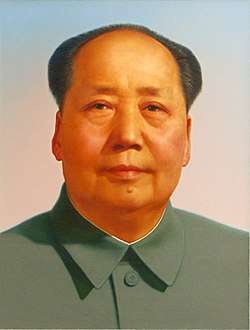 |
 |
| Mao Zedong First Chairman |
Liu Shaoqi 2nd Chairman |
The President of the People's Republic of China is the head of state. Under the PRC's constitution, the presidency is a largely ceremonial office with limited powers.[13] However, since 1993, as a matter of convention, the presidency has been held simultaneously by the General Secretary of the Communist Party of China, top leader in one party system.[14] The office is officially regarded as an institution of the state rather than an administrative post; theoretically, the president serves at the pleasure of the National People's Congress, the legislature, and is not legally vested to take executive action on its own prerogative.[lower-alpha 1] The current president is Xi Jinping, who took office in March 2013.
The office was first established in the Constitution of the People's Republic of China in 1954 and successively held by Mao Zedong and Liu Shaoqi. Liu fell into political disgrace during the Cultural Revolution, after which the office became vacant. The office was abolished under the Constitution of 1975, then reinstated in the Constitution of 1982, but with reduced powers. The official English-language translation of the title was "Chairman"; after 1982, this translation was changed to "President", although the Chinese title remains unchanged.[lower-alpha 2] In March 2018, presidential term limits were abolished.[15]
State Council and Premier
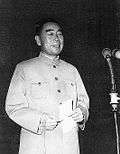 |
.jpg) |
| Zhou Enlai First Premier |
Li Keqiang Current Premier |
The State Council is the chief authority of the People's Republic of China. It is appointed by the National People's Congress and is chaired by the Premier and includes the heads of each governmental department and agency. There are about 50 members in the council. In the politics of the People's Republic of China, the Central People's Government forms one of three interlocking branches of power, the others being the Communist Party of China and the People's Liberation Army. The State Council directly oversees the various subordinate People's Governments in the provinces, and in practice maintains an interlocking membership with the top levels of the Communist Party of China.
Currently the Premier of the State Council is Li Keqiang and the Vice Premiers are Han Zheng, Sun Chunlan, Hu Chunhua and Liu He. Together with the five State Councilors, they form the inner cabinet that regularly convenes for the State Council Executive Meeting.[16]
Central Military Commission
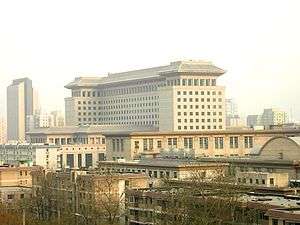
The Central Military Commission exercises the command and control of the People's Liberation Army and is supervised by the Standing Committee of the National People's Congress. The state CMC is nominally considered the supreme military policy-making body and its chairman, elected by the National People's Congress, is the commander-in-chief of the armed forces. In reality, command and control of the PLA, however, still resides with the Central Military Commission of the Chinese Communist Party Central Committee.
Currently the chairman of the Central Military Commission is Xi Jinping.
National Supervisory Commission
The National Supervisory Commission of the People's Republic of China is the highest supervisory (anti-corruption) agency of the People's Republic of China. It supervises all public officials who exercise public power, at the same administrative ranking as the Supreme People's Court and Supreme People's Procuratorate[17]. Its operations are merged with the Central Commission for Discipline Inspection of the Communist Party of China[18]. It replaces the former Ministry of Supervision.
Currently the director of National Supervisory Commission is Yang Xiaodu.
Supreme People's Court and Supreme People's Procuratorate
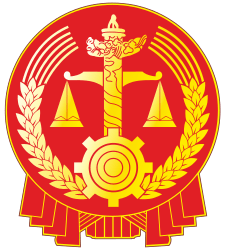

The Supreme People's Court is the highest court in the judicial system of the People's Republic of China. Hong Kong and Macau, as special administrative regions, have separate judicial systems based on British common law traditions and Portuguese civil-law traditions respectively, and are out of the jurisdiction of the Supreme People's Court. The judges of the Supreme People's Court are appointed by the National People's Congress.
As of 2018, the President of Supreme People's Court and the Procurator-General of Supreme People's Procuratorate are Zhou Qiang and Zhang Jun separately.
Provincial and local government
The governors of China's provinces and autonomous regions and mayors of its centrally controlled municipalities are appointed by the central government in Beijing after receiving the nominal consent of the National People's Congress (NPC). The Hong Kong and Macau special administrative regions (SARS) have some local autonomy since they have separate governments, legal systems, and basic constitutional laws, but they come under Beijing's control in matters of foreign policy and national security, and their chief executives are handpicked by the central government. Below the provincial level in 2004 there were 50 rural prefectures, 283 prefecture-level cities, 374 county-level cities, 852 county-level districts under the jurisdiction of nearby cities, and 1,636 counties. There also were 662 cities (including those incorporated into the four centrally controlled municipalities), 808 urban districts, and 43,258 township-level regions. Counties are divided into townships and villages. While most have appointed officials running them, some lower-level jurisdictions have direct popular elections. The organs of self-governing ethnic autonomous areas (regions, prefectures, and counties)—people's congresses and people's governments—exercise the same powers as their provincial-level counterparts but are guided additionally by the Law on Regional Ethnic Autonomy and require NPC Standing Committee approval for regulations they enact "in the exercise of autonomy" and "in light of the political, economic, and cultural characteristics of the ethnic group or ethnic groups in the areas."
Civil service
See also
Notes
- ↑ It is listed as such in the current Constitution; it is thus equivalent to organs such as the State Council, rather than to offices such as that of the premier.
- ↑ In Chinese the President of the PRC is termed zhǔxí while the Presidents of other countries are termed zǒngtǒng. Furthermore zhǔxí continues to have the meaning of "chairman" in a generic context.
References
Citations
- ↑ "How the Chinese government works". South China Morning Post.
Xi Jinping is the most powerful figure in China's political system, and his influence mainly comes from his position as the general secretary of the Chinese Communist Party.
- ↑ Ralph H. Folsom, John H. Minan, Lee Ann Otto, Law and Politics in the People's Republic of China, West Publishing (St. Paul 1992), pp. 76–77.
- ↑ "China 'will not have democracy' China will never adopt Western-style democracy with a multi-party system, its top legislator has said." BBC 9 March 2009, accessed October 9, 2010
- ↑ China bites the bullet on fuel tax. Rsc.org (2009-01-01). Retrieved on 2013-07-21.
- ↑ Bbc News. BBC News. Retrieved on 2013-07-21.
- ↑ Chapter III Central Organizations of the Party - Article 22
- ↑ "China's Next Leaders: A Guide to What's at Stake". China File. 13 November 2012. Retrieved 18 November 2012.
- ↑ "A simple guide to the Chinese government". South China Morning Post.
Xi Jinping is the most powerful figure in the Chinese political system. He is the President of China, but his real influence comes from his position as the General Secretary of the Chinese Communist Party.
- ↑ Higgins, Andrew (2011-01-16). "Hu's visit spotlights China's two faces". The Washington Post. The Washington Post Company. Retrieved 2011-01-17.
- ↑ International Parliamentary Union. "IPU PARLINE Database: General Information". Retrieved 2017-08-06.
- ↑ "State Structure of the People's Republic of China". 中国人大网. The National People's Congress of the People's Republic of China. Retrieved 2016-09-29.
- ↑ "The National People's Congress of the People's Republic of China". Retrieved 2016-11-08.
- ↑ Krishna Kanta Handique State Open University, EXECUTIVE: THE PRESIDENT OF THE CHINESE REPUBLIC.
- ↑ "Does Chinese leader Xi Jinping plan to hang on to power for more than 10 years?". 6 October 2017.
If Xi relinquished the presidency in 2023 but remained party chief and chairman of the Central Military commission (CMC), his successor as president would be nothing more than a symbolic figure... “Once the president is neither the party’s general secretary nor the CMC chairman, he or she will be hollowed out, just like a body without a soul.”
- ↑ https://www.nytimes.com/2018/03/11/world/asia/china-xi-constitution-term-limits.html
- ↑ Heilmann, Sebastian (2017). China's political system. Rowman & Littlefield. pp. 76–80. ISBN 978-1-4422-7736-6.
- ↑ "People's Republic of China Supervision Law (draft)". China Law Translate. China. 6 November 2017. Retrieved 27 January 2018.
- ↑ "Why should the National Supervisory Commission merges its operations with the Central Commission for Discipline Inspection of CPC?(为什么中央纪委与国家监察委员会要合署办公?)". Website of CCDI&NSC. China. 2 Feb 2018. Retrieved 2 April 2018.
Sources

External links
- Official website (in English)
- China e-Government Network
- China Government Innovation Network
- China Government Procurement Information Network
- Chinese Government Public Information Online Service Platform
- Guide to Chinese Government Agencies
- Links to information regarding branches and departments of the PRC
- US-China Business Council's PRC Central Government Structure Report
